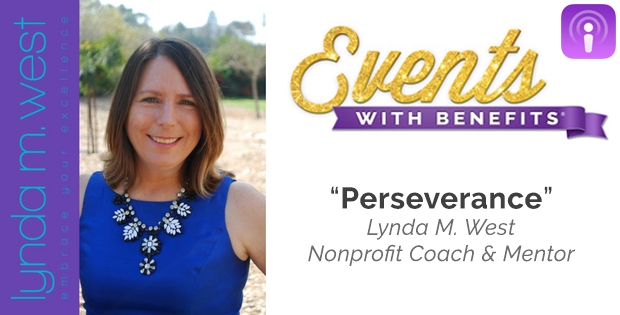So many nonprofits are scared to ask for what they want.
“I’m being an imposition.”
“Asking for the organization sounds like I’m asking for myself.”
“They’ll probably say no.”
Sound familiar?
Fact is, if you don’t ask, you can’t further your programs and multiply your impact.
In today’s post, nonprofit coach Lynda West draws from years of mentoring charities to discuss how peer-to-peer mentoring groups, called “masterminds”, can help you get to the next level of fundraising success. Get 3 concrete tips to gain confidence and ask for what’s needed to achieve your goals.
Then head over to our weekly podcast, Events with Benefits, for the full 30-minute episode all about persevering through many common challenges nonprofits face.

Joining a Nonprofit “Mastermind”
First, what is a “mastermind”?
Forbes defines a mastermind as “a group of smart people [that meets] weekly, monthly, daily even if it makes sense, to tackle challenges and problems together. They lean on each other, give advice, share connections and do business with each other when appropriate.“
Peer-to-peer mentoring can be very powerful. That’s why joining – or creating – a group of like-minded fundraising professionals is the #1 thing you can do to get to your fundraising efforts to the next level. Here’s why.
1. Provides accountability
“I mentor people both remotely (via Zoom web conferencing) and locally,” West says, “and I’ve found that what matters most is not their location, but how much time they’re willing to devote to the program.”
West’s mentoring groups hold anywhere from 2 to 10 professionals, both from nonprofit leaders and for-profit business owners. They meet in 3-hour sessions, once a week.
“Many mentoring groups only meet for one hour a week, then everyone goes their separate ways. Life gets in the way, and inevitably the things you had resolved to finish don’t get done.
“Building in time to start putting ideas into practice is key to a mastermind’s success.”
2. Promotes knowledge-sharing
Everyone has different goals and backgrounds, but you most likely know or have mutual connections with someone who has already acheived the very goal you’re trying to accomplish.
At the level of a mastermind, there are no secrets, says West. People on the street might be considered competitors, yet they come together once a week to work toward mutual goals and progress.
The more successful people are, the more available they are. We naturally like sharing knowledge.
So what knowledge is most commonly being shared among nonprofit pros?
“It boils down to better telling your organization’s stories to potential donors and massaging donor relationships. Too many of the nonprofit professionals I coach will hold their hand out, then disappear; a year later they’ll hold their hand out again, then disappear. They don’t foster the relationship or build lifelong donors, and it’s hurting their sustainability.”
{{cta(‘e0ebb7dd-c7d0-48a4-87fc-3336d86e5373′,’justifycenter’)}}
3. Brainstorm concrete takeaways
The first hour in West’s mastermind program is spent discussing and brainstorming the challenges group members are facing. Each person has the opportunity to share wins for the week, what they’re working on, and what they’re struggling with.
The next two hours are devoted to implementing the suggestions.
“We break it down so challenges are not so overwhelming,” West explains. “And every week we make headway by throwing in those two hours to actually get work done and walk away having accomplished something.”
Event Planning Tips
One of West’s first forays into the world of event fundraising was organizing the Lemon Zest & Garlic Fest, a community summer food festival in San Diego with live entertainment, cooking demonstrations, arts and crafts, and other activities.
Festivals and carnivals always have a unique, frenzied planning dynamic, but the date of the inaugural festival “received the most rain in San Diego’s recorded history,” West recalls. “We had 160 volunteers and ended up selling 700 tickets prior to the event, thanks to my terrific marketing team. It was the biggest event I had ever put on.
“We showed up 7 hours before the event began at 11am to set up the stage, tents, vendor booths and more. Finally we opened the gates at 11… and at 11:05, the skies opened with rain, thunder and lightning in San Diego in July.”
Despite the mayhem that ensued – including ruined band equipment, a shutdown beer garden and plenty of issued refunds – the attendees ended up having a great time. Everyone was smiling and complimenting the enthusiastic volunteers and staff.
“It was certainly an experience that put my feet to the fire, but I learned a lot,” West says. Her key tips for event planners:
1. Reach out and ask for help. Ask people who have been there before. They can tell you what’s going to go wrong before that actually happens. “For me, I learned the importance of having a ‘rain or shine’ clause on the tickets and contracts,” West notes with a laugh.
2. Put together a budget. At the end of the day, should you see you only broke even or perhaps even lost money, you will wish you had made and stuck to a strict budget earlier.
3. Stay the course. Evaluate what went well and what didn’t go right, then keep going next year. The second time around, any event can be improved.
4. Include alternate revenue streams. “The big one is event sponsorships,” advises West. “Get sponsors on board, anywhere from $500 to $100,000. That said, sponsors are inundated with requests all the time, so it’s important to know which sponors align best with your mission.”
{{cta(‘f2a7ad66-bc37-4f6f-ac57-1560c652588b’,’justifycenter’)}}
You also want to prioritize repeat sponsorships: Sponsors who know you well are the best candidates to refer you to people in their network for additional sponsorship. You can ask, ‘Who else do you know that might like to be part of this event?’
Other options include ticket sales; advertising; social media; and holding a live or silent auction. (Click below for a list of 26 creative silent auction basket ideas.)
{{cta(‘e37146f6-a952-413d-b280-e1d0806c2985′,’justifycenter’)}}
Bottom line: “Ask, ask, ask,” West says.
Whether you’re asking donors, event sponsors, vendors and more to assist with your event, remember lots of times it’s just a number game. A “no” could really mean “Not right now” or “I’m not sure,” so it’s always worth asking.
To create your own mastermind group, gather a small group of like-minded event fundraising professionals in your area to exchange ideas and trade strategies. For nonprofit mentoring, visit West’s site at www.LyndaMWest.com. West would be more than happy to set up a discovery call to give you the oomph you need to keep going.
This week on Events with Benefits: Ep. 5, Perseverance
For more on persevering through common nonprofit challenges, please check out the latest episode of our podcast, Events with Benefits (a weekly audio series all about best practices for development and event fundraising). Today’s post was just a taste of the information provided in the episode featuring nonprofit coach and mentor Lynda West.
At age 40, Lynda went from the couch to running a marathon in 4 months – instilling a “never give up” attitude in her that she applies to nonprofit clients today.
In this episode, Lynda shares her firsthand experience mentoring nonprofits, starting her own charity, planning events and working until you reach your goals (plus the importance of a “rain or shine” clause at your next event!).
In the episode you’ll learn…
- How “Masterminding” can help your nonprofit acheive more success
- 3 must-include revenue streams in your fundraising event
- Fundraising trends in 2017
- …and more!
Click here to listen to the podcast and download the free customizable worksheet.
{{cta(‘686c274c-aa73-421a-b402-9139f0882e58′,’justifycenter’)}}


